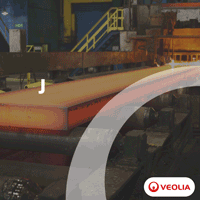worldsteel: Industry, Government Cooperation Necessary for Low-Carbon Future
05/26/2021 - The global steel industry is committed to reducing its carbon footprint, but to succeed, the industry must have the right public policy framework in place, the World Steel Association (worldsteel) says in a new climate change policy paper.
The paper, released last week, says that while producers throughout the world are working to transition to a net-zero carbon future, they face significant capital costs and competitive pressure from conventionally produced steel, challenges they cannot overcome on their own.
“What is absolutely clear is that governments and other stakeholders will need to work with the steel industry to overcome the technological and economic challenges and create the market conditions necessary for the steel industry to transition to low-carbon steelmaking effectively,” said worldsteel director general Edwin Basson.
worldsteel said the industry acknowledges its carbon intensity and is working to reduce its footprint by improving energy and carbon efficiency. It also is promoting further increases in scrap use and is developing and implementing breakthrough technologies that can reduce carbon emissions.
According to Åsa Ekdahl, head of environment and climate change for worldsteel, the industry has an array of breakthrough technologies in various stages of development. So far, she said, they fall into three broad baskets.
One is the use of carbon reductants and technology that prevents the release of fossil-fuel-derived CO2, such as conversion of sustainable biomass coupled with carbon capture utilization and storage. A second category is the substitution of hydrogen for carbon reductants in the production process. And the third is the use of electrical energy in an electrolysis-based process.
“The breakthrough technologies are becoming real,” Ekdahl said, speaking during a recent webinar about the policy paper. “There is lots of activity going on, (as evidenced by) the projects in the research phases as well in the pilot and demonstration phases. And, in a few cases, some are at a commercial stage.”
And the more, the better, Ekdahl said.
“At worldsteel we are absolutely convinced that there is no single solution to low-carbon steelmaking and that we will need a broad portfolio of technical options to be deployed alone or in combination as local circumstances permit,” Ekdahl said.
Given the lack of a one-size-fits-all technological solution, worldsteel said governments should refrain from policies that would create technological winners and losers. But where they will need to intervene, worldsteel said, is in establishing a level playing field for steel that is produced with green technologies.
Ekdahl said green steel production is estimated to cost 10% to 50% more, an increase that exceeds current production margins. And because green steel is likely to be in the market at the same time as conventionally produced steel, there is a “first-mover disadvantage” that will hinder the transition.
worldsteel said governments need to set polices that mitigate the disadvantage by increasing demand for green steels and creating a market for them. But at the same time, governments must not create economic disadvantages for companies that have already invested in efficient steelmaking.
Additionally, worldsteel said that because the transition will come with high capital costs, governments will have to work to ensure that producers have access to finance for the transition. And they must also ensure availability and affordability of low-carbon resources, such as renewable energy and hydrogen.
“Partnerships between governments and the steel industry are fundamental to a sustainable future,” worldsteel wrote in the policy paper.



-(220-x-200-px)-(130-x-130-px)-(220-x-200-px).jpg?lang=en-US&ext=.jpg)
.gif?width=200&height=200&mediaprotectionhash=ddb07947ad3b4ab959a83714461eccd5c6895f370695eb035a9ff7aa736f8ad9&ext=.gif)





